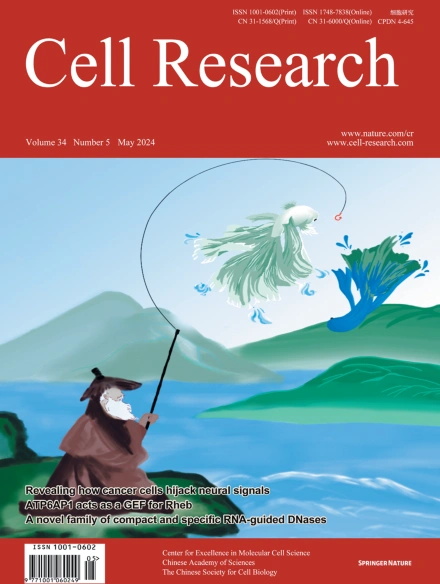
Advanced Search
Submit Manuscript
Advanced Search
Submit Manuscript
Volume 34, No 5, May 2024
ISSN: 1001-0602
EISSN: 1748-7838 2018
impact factor 17.848*
(Clarivate Analytics, 2019)
Volume 34 Issue 5, May 2024: 355-369 |
The rapid proximity labeling system PhastID identifies ATP6AP1 as an unconventional GEF for Rheb
Ran Feng1,2,† , Feng Liu1,†,* , Ruofei Li1 , Zhifen Zhou2 , Zhuoheng Lin1 , Song Lin1 , Shengcheng Deng1 , Yingying Li1 , Baoting Nong2 , Ying Xia1 , Zhiyi Li1 , Xiaoqin Zhong1 , Shuhan Yang1 , Gang Wan1 , Wenbin Ma1 , Su Wu2,* , Zhou Songyang1,2,*
1MOE Key Laboratory of Gene Function and Regulation, State Key Laboratory of Biocontrol, Guangzhou Key Laboratory of Healthy Aging Research, School of Life Sciences, Institute of Healthy Aging Research, Sun Yat-sen University, Guangzhou, Guangdong, ChinaRheb is a small G protein that functions as the direct activator of the mechanistic target of rapamycin complex 1 (mTORC1) to coordinate signaling cascades in response to nutrients and growth factors. Despite extensive studies, the guanine nucleotide exchange factor (GEF) that directly activates Rheb remains unclear, at least in part due to the dynamic and transient nature of protein–protein interactions (PPIs) that are the hallmarks of signal transduction. Here, we report the development of a rapid and robust proximity labeling system named Pyrococcus horikoshii biotin protein ligase (PhBPL)-assisted biotin identification (PhastID) and detail the insulin-stimulated changes in Rheb-proximity protein networks that were identified using PhastID. In particular, we found that the lysosomal V-ATPase subunit ATP6AP1 could dynamically interact with Rheb. ATP6AP1 could directly bind to Rheb through its last 12 amino acids and utilizes a tri-aspartate motif in its highly conserved C-tail to enhance Rheb GTP loading. In fact, targeting the ATP6AP1 C-tail could block Rheb activation and inhibit cancer cell proliferation and migration. Our findings highlight the versatility of PhastID in mapping transient PPIs in live cells, reveal ATP6AP1’s role as an unconventional GEF for Rheb, and underscore the importance of ATP6AP1 in integrating mTORC1 activation signals through Rheb, filling in the missing link in Rheb/mTORC1 activation.
https://doi.org/10.1038/s41422-024-00938-z